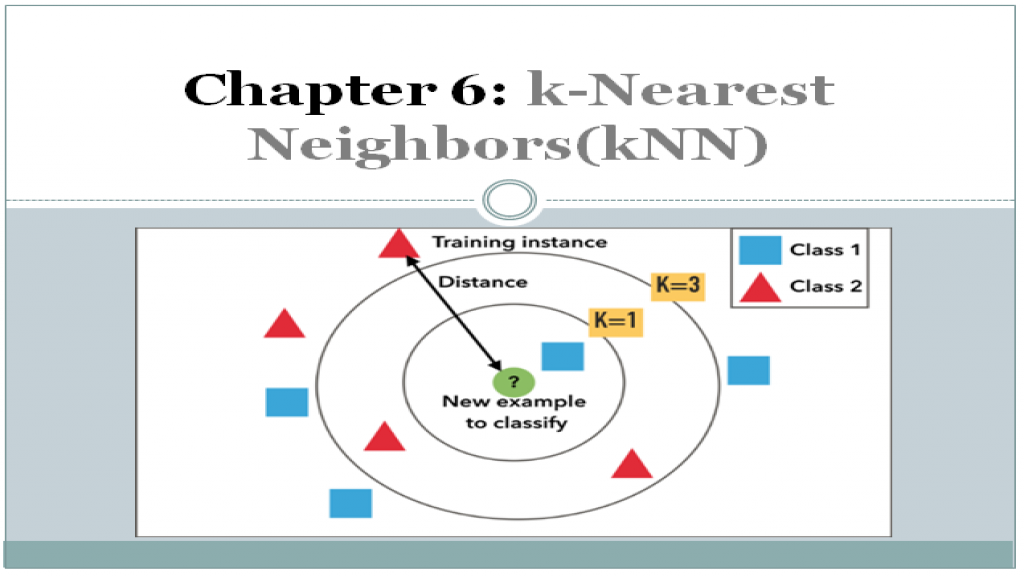K Nearest Neighbour with Python Implementation
K-NEAREST NEIGHBOURS (K-NN)
- KNN falls in the supervised learning family of algorithms.
- The KNN classifier is also a non-parametric and instance-based learning algorithm:
1. Non-parametric means it makes no explicit assumptions about the functional form of h, avoiding the dangers of mismodeling the underlying distribution of the data.
2. Instance-based learning means that our algorithm doesn’t explicitly learn a model. Instead, it chooses to memorize the training instances which are subsequently used as “knowledge” for the prediction phase.
- K-NN algorithm assumes the similarity between the new case/data and available cases and put the new case into the category that is most similar to the available categories.
- K-NN algorithm stores all the available data and classifies a new data point based on the similarity.
- K-NN algorithm can be used for Regression as well as for Classification but mostly it is used for the Classification problems.
- It is also called a lazy learner algorithm because it does not learn from the training set immediately instead it stores the dataset and at the time of classification, it performs an action on the dataset.
- KNN algorithm at the training phase just stores the dataset and when it gets new data, then it classifies
that data into a category that is much similar to the new data.
DISTANCE METRICS
- Minkowski Distance
- Euclidean Distance
- Manhattan Distance
Note : Manhattan distance is always greater than equal to Euclidean distance. Condition in which both of them are equal is when we calculate the distance in 1-d space.

MINKOWSKI DISTANCE
Minkowski distance is a metric in Normed vector space.
- A Normed vector space is a vector space on which a norm is defined.
- Suppose X is a vector space then a norm on X is a real valued function ||x||which satisfies below conditions -
• Zero Vector- Zero vector will have zero length.
• Scalar Factor- The direction of vector doesn’t change when you multiply it with a positive number though its length will be changed.
• Triangle Inequality- If distance is a norm then the calculated distance between two points will always be a straight line.
Note : Normed vector space means co ordinate axis.
This is generalization formula for calculating distance.

in formula n is the number of dimensions and p is the integer value.
P VALUE VARIANTS
- p = 1, Manhattan Distance
- p =2, Euclidean Distance
- p = infinity , Chebyshev Distance
HOW DOES IT WORKS?
STEP 1: Choose the number K of neighbors.
STEP 2: Take the K nearest neighbors of the new data point, according to the Euclidean distance.
STEP 3: Among these k neighbors, count the number of data points in each category.
STEP 4: Assign the new data point to the category where you counted the most neighbors.
Your model is ready
MANHATTAN DISTANCE


are used when dimensions>=5 and are useful if the dataset is robust to outliers.
EUCLIDEAN DISTANCE


STEP 1: CHOOSE THE NUMBER K OF NEIGHBOURS: K=5

STEP 2 : TAKE K=5 NEAREST NEIGHBOURS OF THE NEW DATA POINT ACCORDING TO THE EUCLIDEAN DISTANCE

STEP 3 : AMONG THESE NEIGHBORS COUNT THE NUMBER OF NEIGHBOURS IN EACH CATEGORY

STEP 4 : ASSIGN THE NEW DATASET TO THE CATEGORY WHERE YOU COUNTED THE MOST NEIGHBORS

Model is ready
HOW TO FIND THE IDEAL K ?
- Using odd numbers, fit a KNN classifier for each number.
- Create predictions.
- Further evaluate the performance using the predictions produced in step 2.
- Compare results across each model and decide on the one with the least error.
Note : If number of classes in the target is N then K should not be divisible by N .
ASSUMPTIONS
- KNN assumes that the data is in a feature space.
- The KNN algorithm assumes that similar things exist in close proximity. In other words, similar things are near to each other. “Birds of a feather flock together.”
- Each of the training data consists of a set of vectors and class label associated with each vector. In the simplest case , it will be either + or – (for positive or negative classes). But KNN , can work equally well with arbitrary number of classes.
- We are also given a single number "k" .
ADVANTAGES
- The algorithm is versatile- It can be used for classification, regression, and search.
- No Training Period- KNN modeling does not include training period as the data itself is a model which will be the reference for future prediction and because of this it is very time efficient in term of improvising for a random modeling on the available data.
- Easy Implementation- KNN is very easy to implement as the only thing to be calculated is the distance between different points on the basis of data of different features and this distance can easily be calculated using distance formula such as- Euclidian or Manhattan
- As there is no training period thus new data can be added at any time since it wont affect the model.
- There’s no need to build a model, tune several parameters, or make additional assumptions.
DISADVANTAGES
- Does not work well with large dataset as calculating distances between each data instance would be very costly.
- The algorithm gets significantly slower as the number of examples and/or predictors/independent variables increase.
- Does not work well with high dimensionality as this will complicate the distance calculating process to calculate distance for each dimension.
- Sensitive to noisy and missing data.
- Feature Scaling- Data in all the dimension should be scaled (normalized and standardized) properly .
Python Implementation Of KNN





- Ankit Yadav
- Dec, 27 2022

